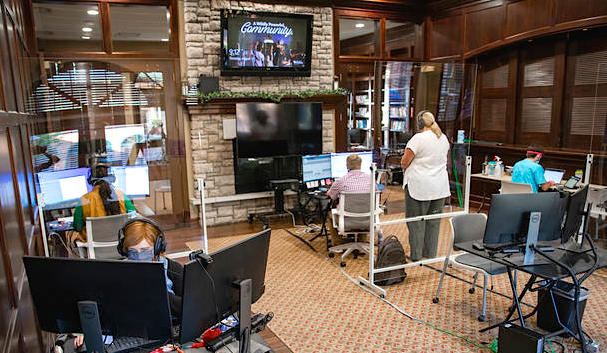Contact tracer at UK describes how the process works

University of Kentucky contact tracers work in the Boone Center, the former faculty club, which has been closed. (UK photo by Pete Camparoni)
—–
By Lindsey Piercy
University of Kentucky
It’s 8 a.m., and it’s time for Eryn Clayton to pick up the phone and begin dialing.
There’s a pause as the call connects.
A University of Kentucky student is on the other end. Clayton smiles sympathetically as she introduces herself; she will be the first to inform them they have tested positive for covid-19.
“That call can be really hard for some to receive, and expected for others,” says Clayton, part of Health Corps, UK’s main tool for keeping the pandemic from closing the campus again.
Clayton is trying to keep the mood light — not because the call isn’t serious. In fact, it’s just the opposite, and getting a stranger to trust you is a monumental task.
“I have to be ready throughout the day to have open conversations, provide guidance as best I can and ultimately make sure the person on the other end, and their friends and families, are safe,” she says.
As the conversation continues, Clayton works to educate the patient — inform them of what their test result means, and provide them with important resources. She details symptoms, high-risk pre-existing medical conditions, what to do if more severe symptoms develop, and helps to create an isolation plan. (Those who test positive are in isolation; those who come into close contact with a positive case are quarantined to prevent the spread of the virus in case they have contracted it.)
Who gets a call and who doesn’t?
Then comes the contact tracing. Clayton tries find out where they’ve been, and more specifically, who they’ve been around. With each interaction, the web widens.
Clayton picks up the phone again, explaining, “We start reaching out to the UK-affiliated contacts and inform them they came into close contact with someone who tested positive for covid-19.”
All students, faculty and staff at UK are considered a contact when they have high-risk exposure (close contact) with a positive case. The Centers for Disease Control and Prevention defines “close contact” as within six feet for more than 15 minutes, “but there are also various extensions of this, as you can imagine the multitude of circumstances where respiratory droplets could pass from one person to another,” Clayton says. “As a basis though, this is how we determine who is a contact and who is not.”
If the infected person has contacts who are not members of the UK community, Health Corps sends those names to the individual’s local health department, which reaches out to them about testing and isolation.
Those who get a call from any contact tracer are not told the name of the person they came into contact with; that information remains confidential.
“The difficult part is that so much of this is a waiting game — but it’s powerful,” Clayton says. “It’s difficult in the scenario where a contact can feel perfectly healthy but must quarantine for a full 14 days. A negative test result following close contact does not mean someone is free from developing the virus within that 14-day period. But if a person in quarantine does develop the virus due to their close contact, then they won’t be able to spread it.”
Everyone Clayton contacts will receive documentation that they have been asked to isolate or quarantine, and they may use that dated material to make the necessary arrangements. In addition, Health Corps ensures every student has a plan to quarantine or isolate safely — regardless of whether a student lives on or off campus. Through this process, UK is offering students a unique level of support and options that non-university-goers may not have.
What happens after the initial conversation?
Following their conversation with a contact tracer, those who test positive will receive a call from a wellness connector.
If symptoms are mild, the individual will be asked to continue communicating with their local health department. If concerns are noted, the patient receives immediate follow-up depending on needs.
The health department where the individual is isolating will provide the written release from isolation to those who tested positive. That documentation must be sent to Health Corps. Once that document has been received, a team member will respond through email with a final release.
While not required, Clayton says she encourages those who test positive to have conversations with those who might be affected — such as roommates, professors or bosses.
Contact tracers will only notify those who were within close contact to a positive case and are at the highest risk of spreading the virus. “That being said, we are not reporting to faculty that someone will not be in class due to testing positive,” Clayton says. “That is the responsibility of the student.”
While each day is never quite the same, one goal remains constant — to keep the UK community as safe as possible.
“I love that as a contact tracer, I get to talk to students one-on-one every day,” Clayton says. “UK is a big school, but every person who tests positive gets a call from someone who wants to help and understand how their feeling. Personal interaction, individual care and education is what ultimately makes a huge impact here.”